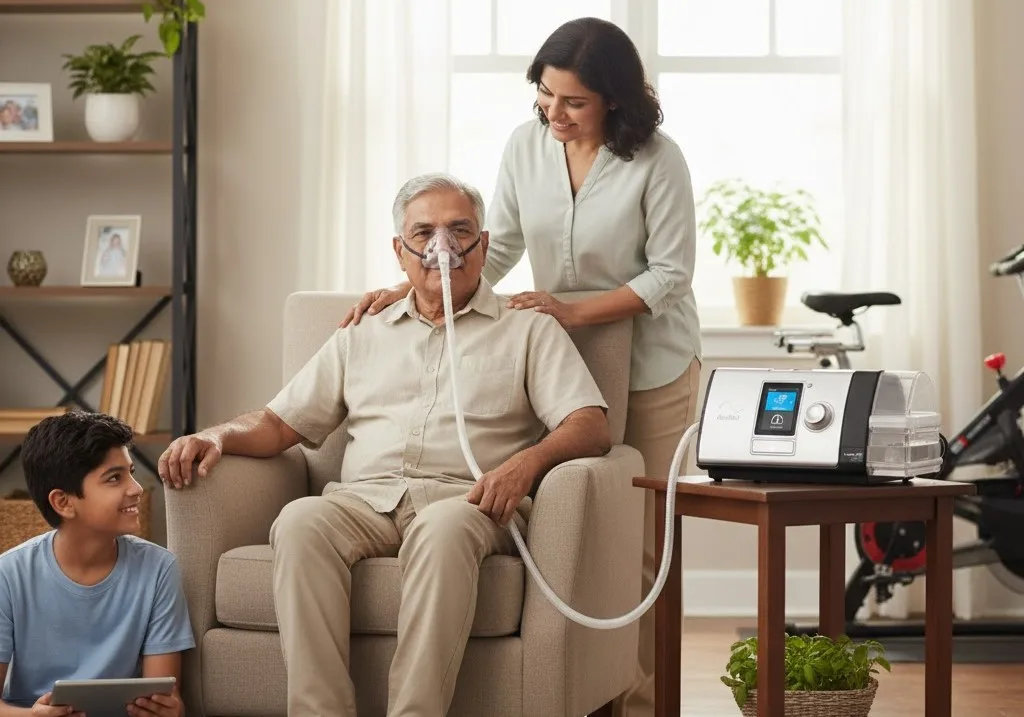

Living with Chronic Obstructive Pulmonary Disease (COPD) can feel overwhelming—not just for the patient, but also for their family. Every breath can become a struggle, and daily life requires careful planning and adaptation. But with the right strategies, tools, and support, life at home can become significantly more comfortable and manageable.
In this case study, we explore the real-life journey of Mr. Ramesh*, a 65-year-old COPD patient, and his family as they navigate life with COPD at home.
Ramesh was diagnosed with COPD five years ago. At first, he struggled with frequent coughing, breathlessness, and low energy levels. Simple tasks like climbing stairs or walking short distances became exhausting.
His family noticed the need to make home adjustments to ensure safety and comfort. They started with small changes—like placing chairs in every room, keeping essential items within easy reach, and creating a calm, well-ventilated living environment.
Managing COPD isn’t only about medications—it’s about adapting daily life. Ramesh and his family implemented routines to reduce strain and conserve energy:
These simple adjustments helped Ramesh regain a sense of control over his daily life.
One major breakthrough in Ramesh’s journey was oxygen therapy and the use of a BiPAP machine.
With proper training, Ramesh learned to use these devices at home, leading to better symptom control and improved quality of life.
Caring for a COPD patient can be demanding. Ramesh’s family faced challenges like:
They overcame these hurdles through:
By sharing responsibilities and staying informed, the family reduced stress and improved care efficiency.
After implementing home care strategies and using Healthy Jeena Sikho’s recommended equipment, Ramesh noticed significant improvements:
Family members also reported feeling more capable and less anxious about caregiving.
1. What is COPD and how does it affect daily life?
COPD, or Chronic Obstructive Pulmonary Disease, is a progressive lung condition that makes breathing difficult. Daily tasks like walking, climbing stairs, or even talking for long periods can become exhausting without proper care.
2. Can COPD be managed at home?
Yes! With proper lifestyle adjustments, breathing exercises, medication, and home equipment like oxygen therapy or BiPAP machines, COPD can be effectively managed at home.
3. How does oxygen therapy help COPD patients?
Oxygen therapy increases oxygen levels in the blood, reducing breathlessness and fatigue. It helps patients perform daily activities more comfortably and improves overall quality of life.
4. What is a BiPAP machine and who needs it?
A BiPAP (Bilevel Positive Airway Pressure) machine assists breathing, especially during sleep. Patients with moderate to severe COPD or sleep-related breathing difficulties benefit the most from it.
5. How often should COPD equipment like masks or tubing be cleaned or replaced?
Equipment should be cleaned daily or as instructed by the manufacturer. Masks, tubing, and filters typically need replacement every few months to maintain hygiene and therapy effectiveness.
6. What lifestyle changes can help manage COPD at home?
7. How can family members support a COPD patient?
Family support is crucial. Caregivers can help by:
8. When should a COPD patient seek medical help?
Seek immediate medical attention if there’s sudden worsening of breathlessness, bluish lips or fingers, high fever, or chest pain. Regular check-ups with a healthcare provider are also essential for long-term management.
Ramesh’s journey highlights that living with COPD at home is possible with the right strategies and equipment. From routine adjustments to oxygen therapy and BiPAP machines, small changes can lead to significant improvements in comfort and quality of life.
CTA: Discover how home care equipment can improve life with COPD. Visit:healthyjeenasikho.com to explore solutions designed for patients and caregivers alike.